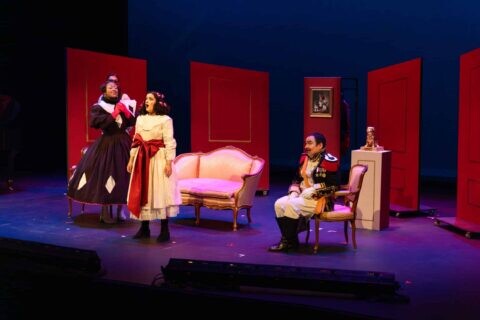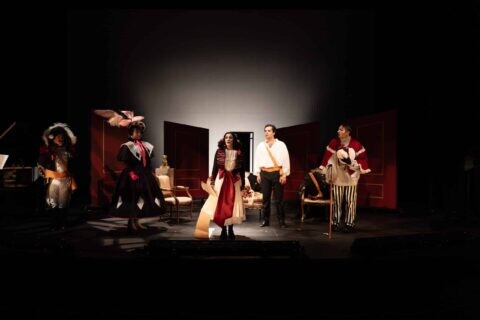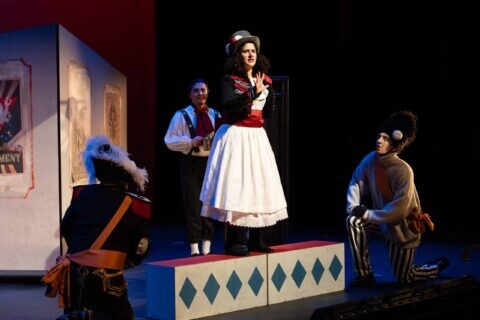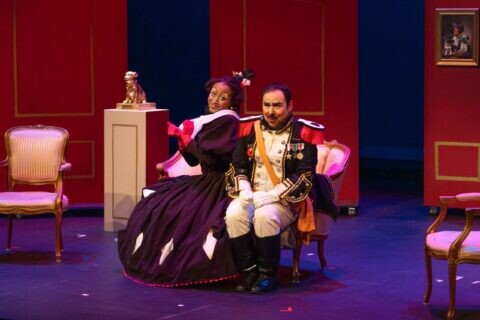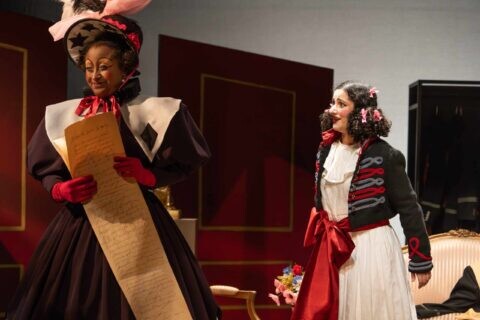La fille sans régiment
In co-production with the Festival d’opéra de Québec
Proud sponsor of JM Canada’s opera
In the Tyrol, occupied by Napoleon 1er’s troops, Marie the vivandière is the object of true love for Tonio, a young Tyrolean ready to do anything to marry her. Adopted as a child by the Twenty-First, a renowned French regiment, Marie miraculously reconnects with her true family in the form of her aunt, the Marquise of Berkenfield, who wishes to marry her to the Duke of Crakentorp. In this French opéra comique by Donizetti, discover lyrical arias that will delight both your ears and your heart, including the famous aria for tenor “Ah! mes amis, quel jour de fête!”, with its nine repeated high Cs, and Marie’s joyful arias that celebrate France, love and the best regiment in the world!
CAST
Marie – Thera Barclay, soprano
Tonio – Jeremy Scinocca, tenor
Marquise de Berkenfield – Queen Hezumuryango, mezzo-soprano
Sulpice – Emanuel Lebel, baritone
Hortensius, Corporal, and Duke – Maxence Lasserre-Engberts, bass-baritone
Martine Jomphe, piano
(Rosane Lajoie, piano for the Festival d’opéra de Québec)
CREATIVE TEAM
Stage Direction : Nathalie Deschamps
Musical Direction : Louise Pelletier
Lighting Design : Anne-Catherine Simard-Deraspe
Hairstyle design : Élène Pearson and Emily Wahlman
Make-up design : Élène Pearson
Assistant stage director and tour manager : Thomas Lussier
Set designer and accessory : Vivienne Angélique
Set designer – costumes : Emily Wahlman
Technical Direction : Olivier Gascon
Direction on Tour : Jean Sabourin
Lighting and set design: Elisabeth Lavoie
Surtitles: William Dorais
A FIRST LOOK AT THE REPERTOIRE
G.DONIZETTI (1797-1848)
Chacun le sait* ÉCOUTEZ
Pour une femme de mon nom** ÉCOUTEZ
* Audio file recorded by Vanessa Croome (soprano) and Esther Gonthier (piano).
** Audio file recorded by Martina Myskhlid (mezzo-soprano) and Esther Gonthier (piano).
Recording and editing by Pierre Léger.
Born in Bergamo, northern Italy, Gaetano Donizetti came from a poor working-class background. He was fortunate enough to benefit from the charitable music lessons given by choirmaster Simon Mayr, who encouraged him to pursue a musical education in Bologna. His first opera premiered in Venice in 1818, paving the way for an impressive series of over 70 operas in 30 years. Following his marriage to Virginia Vasselli, Donizetti moved to Naples, where he enjoyed a number of triumphs, including the premiere of Lucia di Lammermoor at the Teatro San Carlo in 1835. This period in Naples also saw the birth of his masterpieces Anna Bolena (1830) and L’Elisir d’amore (1832). In 1838, the composer settled in Paris, where he created memorable new works such as La fille du régiment (1840) and Don Pasquale (1843). He then moved to Vienna, where he was appointed Kapellmeister to the imperial court in 1842. Stricken by cerebral palsy in 1845, he returned to his native Bergamo, where he died three years later.
A contemporary of Rossini and Bellini, Gaetano Donizetti was a leading exponent of Italian Romantic opera and one of the great masters of opéra comique. Unlike the conventional opera seria, which borrows its subject from mythology and seeks a moral denouement where forgiveness triumphs, opéra romantique or comique as practised by Donizetti borrows its subjects from modern history and features tragic or comic endings. In Donizetti’s work, historical subjects do not have a political dimension, as would be the case with Verdi in the following generation: rather, they are springboards for the art of bel canto, which seeks to showcase the singers’ exceptional vocal talent through virtuoso, colourful, and spectacular writing.
In 1838, frustrated by Neapolitan censorship and buoyed by the success of Lucia di Lammermoor in Paris, Donizetti left Naples to settle in the French capital. He gradually won over the major Parisian theatres and, in 1840, presented a new opera for the Opéra Comique, closely linked to the political context of the time. Since 1830, the idea of repatriating Napoleon’s remains to France had been gaining traction, and things accelerated at the end of the 1830s. The emperor, still very much in people’s minds, was also on everyone’s lips and in every newspaper. The setting for this new opéra comique is Napoleon’s regiment of grenadiers, whose patriotic spirit was sure to appeal to Parisian audiences. Nevertheless, the premiere received a lukewarm reception—partly due to the poor performance of the tenor playing Tonio, and partly due to the libretto, which Berlioz criticized. It was only in 1848, with a new cast, that La fille du régiment finally met with success, and has since become a regularly performed work around the world.
Act I: Tyrolean peasants are praying on a hillside as they watch French soldiers approach their village. A marchioness on a trip with her steward happens to be there, and sings of her discomfort at the situation: “Les brigands de Français ne respectent rien!” Finally, the French troops, who had not come to fight, go on their way. And now we’re back in the midst of the regiment, where the soldiers are singing the praises of their little Marie, the young orphan found as a child on a battlefield, who has followed them and become their vivandière—a girl who provides them with food and drink. Marie has a crush on Tonio, a young Tyrolean peasant she met a few days earlier, and now he’s been arrested by the soldiers, only to be freed by Marie’s intervention, who sings the regimental song “Chacun le sait, chacun le dit…” Out of love for Marie, who has vowed to marry only one of the regiment’s soldiers, Tonio enlists as a private and sings the famous “Ah! Mes amis,” a particularly virtuoso aria with its many high Cs. In the meantime, the marchioness arrives, recognizing Marie as her niece and deciding to take her back to her castle to educate her. The farewells are bitter: “Au diable, la marquise!”
Act II: At the marchioness’s castle, Marie is learning good manners in preparation for her marriage to a German nobleman, who will make her a duchess against her wishes. Sulpice, a sergeant of the brigadiers who is staying at the castle after having been wounded, reminds her of the regiment. Just then, the soldiers of the regiment arrive at the castle; Marie is overjoyed to welcome her “family” and sings “Tous les trois réunis, quel plaisir!” as a trio with Tonio and Sulpice. The marchioness returns and insists on finalizing Marie’s marriage. The soldiers promise to return, and this is when the marchioness confesses to Sulpice that Marie is not her niece, but rather her illegitimate daughter. The secret remains safe until the moment of signing before the notary, when the soldiers return, singing of Marie’s earlier days as a vivandière and daughter of the regiment. High society is shocked and no longer approves of the marriage; Marie is relieved and can reunite with Tonio, with the marchioness’s consent in a patriotic finale: “Salut à la France, à ses beaux jours, à l’espérance, à leurs amours.”



